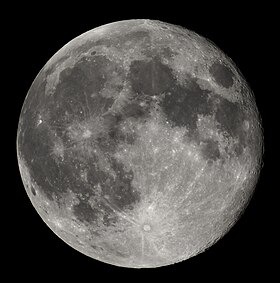The Moon is Earth's only natural satellite and is the fifth largest satellite in the Solar System. It is the largest moon in the Solar System relative to the size of its planet, a quarter the diameter of Earth and 1/81 its mass, and is the second densest satellite after Io. It is in synchronous rotation with Earth, always showing the same face; this near side is marked with dark volcanic maria among the bright ancient crustal highlands and prominent impact craters. Despite being the brightest object in the sky after the Sun, its surface is actually very dark, with a similar reflectance to coal. Its prominence in the sky and its regular cycle of phases have since ancient times made the Moon an important cultural influence on language, the calendar, art and mythology. The Moon's gravitational influence produces the ocean tides and the minute lengthening of the calendar year. The Moon's current orbital distance, about thirty times the diameter of the Earth, causes it to be the same size in the sky as the Sun – allowing the Moon to cover the Sun precisely in total solar eclipses.
The Moon is the only celestial body on which human beings have made a manned landing. While the Soviet Union's Luna programme was the first to reach the Moon with unmanned spacecraft, the United States' NASA Apollo program achieved the only manned missions to date, beginning
 A full Moon as seen from Earth's northern hemisphere | ||||||||||
| Designations | ||||||||||
|---|---|---|---|---|---|---|---|---|---|---|
| Adjective | lunar | |||||||||
| Orbital characteristics | ||||||||||
| Perigee | 363,104 km (0.0024 AU) | |||||||||
| Apogee | 405,696 km (0.0027 AU) | |||||||||
| Semi-major axis | 384,399 km (0.00257 AU[1]) | |||||||||
| Eccentricity | 0.054 9[1] | |||||||||
| Orbital period | 27.321582 d (27 d 7 h 43.1 min[1]) | |||||||||
| Synodic period | 29.530589 d (29 d 12 h 44 min 2.9 s) | |||||||||
| Average orbital speed | 1.022 km/s | |||||||||
| Inclination | 5.145° to the ecliptic[1] (between 18.29° and 28.58° to Earth's equator) | |||||||||
| Longitude of ascending node | regressing by one revolution in 18.6 years | |||||||||
| Argument of perigee | progressing by one revolution in 8.85 years | |||||||||
| Satellite of | Earth | |||||||||
| Physical characteristics | ||||||||||
| Mean radius | 1,737.10 km (0.273 Earths)[1][2] | |||||||||
| Equatorial radius | 1,738.14 km (0.273 Earths)[2] | |||||||||
| Polar radius | 1,735.97 km (0.273 Earths)[2] | |||||||||
| Flattening | 0.00125 | |||||||||
| Circumference | 10,921 km (equatorial) | |||||||||
| Surface area | 3.793 × 107 km2 (0.074 Earths) | |||||||||
| Volume | 2.1958 × 1010 km3 (0.020 Earths) | |||||||||
| Mass | 7.3477 × 1022 kg (0.0123 Earths[1]) | |||||||||
| Mean density | 3,346.4 kg/m3[1] | |||||||||
| Equatorial surface gravity | 1.622 m/s2 (0.165 4 g) | |||||||||
| Escape velocity | 2.38 km/s | |||||||||
| Sidereal rotation period | 27.321582 d (synchronous) | |||||||||
| Equatorial rotation velocity | 4.627 m/s | |||||||||
| Axial tilt | 1.5424° (to ecliptic) 6.687° (to orbit plane) | |||||||||
| Albedo | 0.136[3] | |||||||||
| Surface temp. equator 85°N[4] |
| |||||||||
| Apparent magnitude | −2.5 to −12.9[nb 1] −12.74 (mean full Moon)[2] | |||||||||
| Angular diameter | 29.3 to 34.1 arcminutes[2][nb 2] | |||||||||
| Atmosphere[5][nb 3] | ||||||||||
| Surface pressure | 10−7 Pa (day) 10−10 Pa (night) | |||||||||
| Composition | H, He, Na, K, Rn, Ar | |||||||||
with the first manned lunar mission by Apollo 8 in 1968, and six manned lunar landings between 1969 and 1972 – the first being Apollo 11 in 1969. These missions returned over 380 kg of lunar rocks, which have been used to develop a detailed geological understanding of the Moon's origins (it is thought to have formed some 4.5 billion years ago in a giant impact), the formation of its internal structure, and its subsequent history. Since the last Apollo mission in 1972, the Moon has been visited only by unmanned spacecraft. Since 2004, Japan, China, India, the United States, and the European Space Agency have each sent lunar orbiters. These spacecraft have confirmed the discovery of lunar water ice in permanently shadowed craters at the poles and bound into the lunar regolith. Future manned missions to the Moon are planned but not yet underway; the Moon remains, under the Outer Space Treaty, free to all nations to explore for peaceful purposes.



0 comments:
Post a Comment